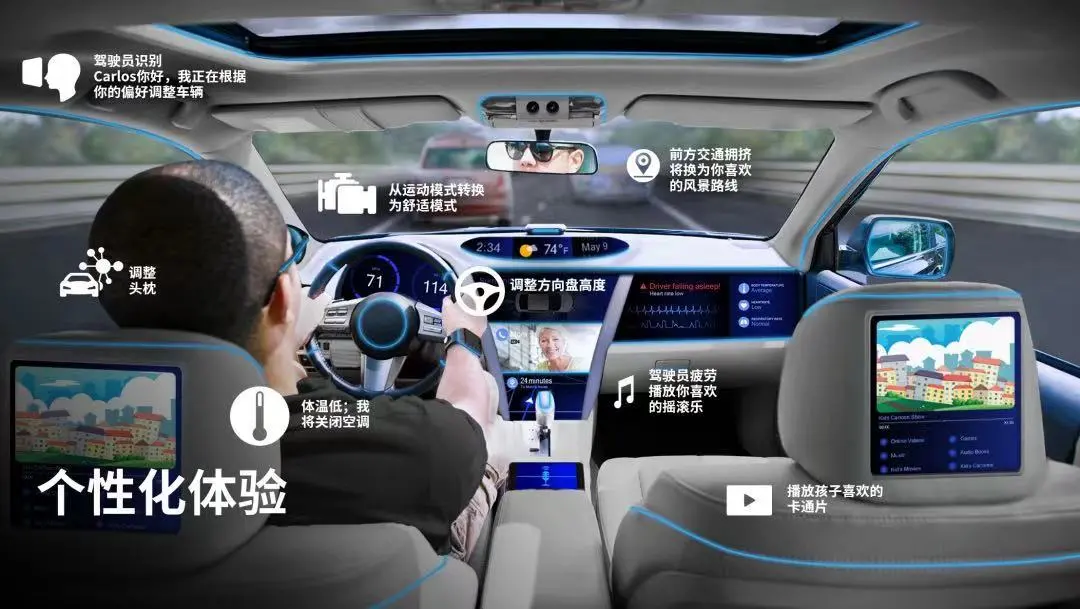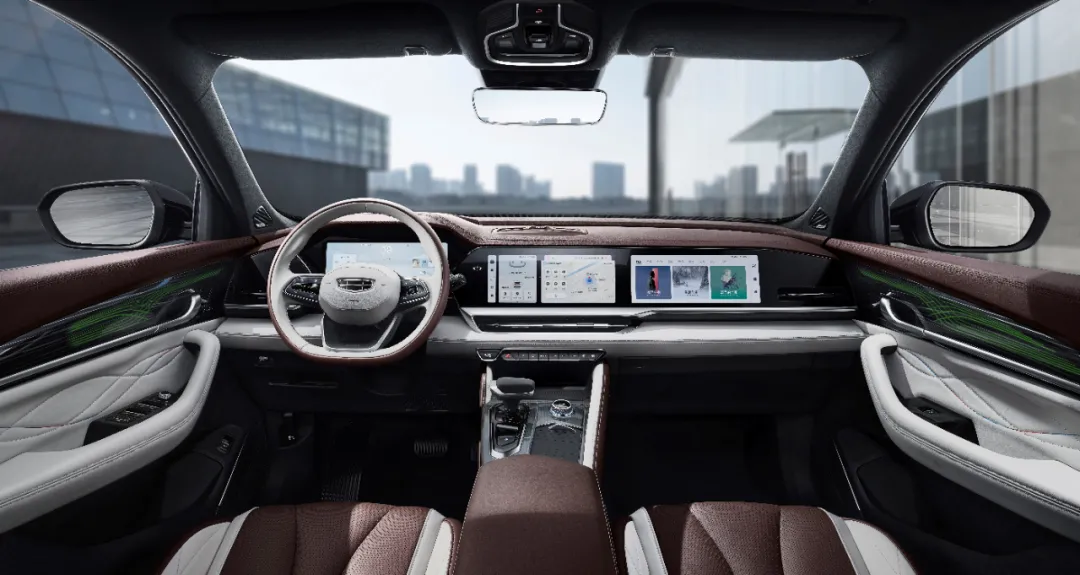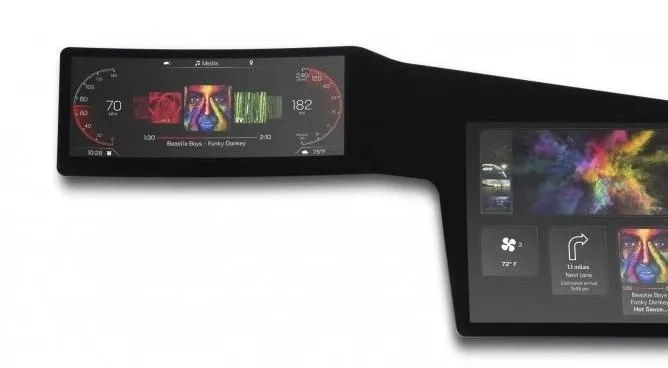Outing 100 People’s Media Focuses on the Evolution of the Automotive Travel Industry Chain
Author: Zheng Wen
“Five years ago, every time we went to an OEM, we had to spend a lot of time explaining what an intelligent cockpit is. It’s unexpected that now this concept is universally known and has become a selling point for many new cars.”
When it comes to the development history of intelligent cockpits, Hong Yiwen, the product manager of Wei Shitong cockpit domain controller, is deeply moved.
Taking the Geely flagship SUV Star Yue L, which was launched in late July, as an example, one of its selling points is the intelligent cockpit. This car has only been on the market for 10 days, and its sales have reached 6,059 vehicles, with more than 30,000 pre-orders.
The intelligent cockpit of the Star Yue L is full of technology, consisting of a “giant screen” of the cockpit composed of a 25.6-inch AR-HUD, a 12.3-inch full LCD instrument panel, a 12.3-inch central control touch screen, and a 12.3-inch exclusive touch screen for the co-driver, allowing users to smoothly interact with information, navigation, and entertainment functions between the instrument, central control screen, and co-driver screen. It can also realize stereoscopic linkage function on the central control screen by implementing split-screen function.
“This intelligent cockpit is a joint effort of Qualcomm, Wei Shitong, and Yikatong. However, our division of labor is very clear,” Hong Yiwen introduced. Qualcomm is a chip supplier, Wei Shitong is responsible for the bottom layer software from driver to operating system, and Yikatong is responsible for the top layer software.
It is worth mentioning that the Star Yue L is a fuel-powered model. Its release means that the intelligent cockpit is no longer the patent of high-end electric vehicles.
Let us take the opportunity of this car’s launch to take a look at the past and present of the intelligent cockpit industry and its competitive landscape.
Intelligent Cockpit: The Entrance to Software-Defined Cars
In the 1960s to 1990s, the car cockpit was mainly composed of mechanical instrument panels and simple audio playback devices with basically physical buttons.
After 2000, the central LCD screen began to appear, and the screen gradually increased from 6 inches to 8 inches. In 2009, with the entry of OnStar into China, the concept of the connected car began to emerge, driving the first integration of cars and technology.
The first to smell the money brought by the new trend was Huaqiangbei in Shenzhen.
After 2015, various types of car navigation systems quickly appeared in the retrofit market. A retrofit car machine with only basic functions such as navigation and music and equipped with a Wince or Linux system can be sold for 2,000-3,000 yuan, more profitable than making counterfeit mobile phones. However, the business of “distributed discrete control” is doomed to not go far, and the businessmen in Huaqiangbei clearly have no ability to change the overall underlying logic of the cockpit.The concept of “new four modernizations” – electrification, interconnection, intelligence, and sharing – began to rise in the automotive industry amidst the “Tesla Effect” driven by the rise of new electric car players. Traditional car manufacturers have also taken action, fearing that they are not changing fast enough to avoid becoming the “Nokia” of the automotive industry.
Although the concept of a smart cockpit was not yet formally introduced at that time, the trend toward integration of the interior space was already becoming increasingly evident:
- The central control screen became larger, and then appeared in various forms such as HUD from a single to multiple screens.
- The interactive touchpoints with users evolved from traditional buttons to touch screens, and then to intelligent voice, gestures, and expressions.
- The direction of evolution for the interior and seating systems towards safety and comfort was consistent with the trend towards intelligentization.
In 2018, Visteon once again led the technological trend by releasing the SmartCore intelligent cockpit system at CES and bringing mainstream domain controller solutions to the market. The following year, the all-new Mercedes-Benz A-Class became the first car to feature this technology, officially ushering the cockpit into the early stage of the intelligent era.
In this wave, the entire intelligent cockpit industry chain is like a thriving big tree with developed roots and lush branches. According to Visteon’s data, the global market size of intelligent cockpit main products including central control screens, information and entertainment solutions, instrument panels, HUDs, etc., is expected to reach USD 46.1 billion by 2022.
Upstream products mainly cover traditional electronic products such as chip layers, bottom layer operating systems and virtual layers, middleware layers, application layers, power semiconductors, and mechanical electronics such as displays/PCBs in the intelligent cockpit industry chain.
In the area of intelligent cockpit chip SoC (System on Chip), companies such as Qualcomm, Intel, and Renesas layout for the high-end market, with Qualcomm almost monopolizing this market. For the low-end market, there are companies such as NXP, Texas Instruments, and STMicroelectronics.
The Geely Star Plus is powered by the Qualcomm Snapdragon 8155 chip, which is built with 7-nanometer technology. The CPU and GPU capabilities of this digital cockpit SoC are 105K DMIPS and 1000GFLPOS respectively. It is reported that Snapdragon chips are already configured in high-priced models such as the Li Xiang ONE, Audi A4L, and NIO ET7.# Intelligent Cockpit Architecture
Many major Chinese internet technology companies have entered the field of operating systems, such as the popular Huawei HarmonyOS and the earlier AliOS.
The application layer of intelligent cockpit software is located at the top level and directly faces users, influencing their intuitive experience. It includes features such as map navigation, voice assistants, car communication modules and app stores.
For example, Yikatong, in conjunction with syntax and deep neural networks, has developed an NLP (natural language processing system) that functions as the AI “brain” for the intelligent voice system in the Star Yue L cockpit app layer. Based on a rich and extensive speech knowledge base, it integrates voice wake-up, speech recognition, context understanding, speech interruption, multi-turn conversation, and partition recognition technology.
Mid-range products mainly include: car entertainment systems (i.e. central control screen + in-car information system), driving information display systems (i.e. dashboard), HUD head-up display, streaming rearview mirror, driving recorder, backseat LCD display, etc.
There is no doubt that the intelligent cockpit is an entry point for software-defined cars. Its evolution basically conforms to the trend of the evolution of the entire vehicle architecture.
A traditional car has over 70 electronic control units (ECUs), each independent and from different suppliers, without information exchange or OTA upgrades like smartphones. This type of traditional car comes from a distributed E/E architecture.
Tesla is known as a disruptor because its electronic and electrical architecture is different from that of traditional car companies. Its leading architecture is the integration of over 70 ECUs into a “domain” managed by a system control unit that simplifies the logic of electronic function implementation.
From a technical implementation perspective, each domain is managed by a high-performance ECU for complex function deployment and distribution, and the “domain controller” is responsible for these “trivial” tasks. All ECUs are classified into three domains: central computing module (CCM), left body control module (BCM LH), and right body control module (BCM RH).
The central computing module can implement the functions of the driving assistance system (ADAS), the information entertainment system (IVI), and the external connection and in-car communication system domains. The left and right body control modules are used to implement the functions of traditional body and convenience systems, chassis safety systems, and some power systems.
New Competition Pattern under Domain Architecture
It is foreseeable that the intelligent cabin era triggered by the “domain controller” is accelerating and the intelligent cabin will become an important anchor point in the global automotive industry.
Looking across the entire intelligent cabin industry, many technology companies have joined the competition in addition to traditional automotive parts companies, and there are many participants. At the same time, hot money continues to flow in, and “arms race” has already begun for the companies that enter the arena.
Traditional automotive parts companies, including Bosch, Continental, and Desay SV, started from cockpit parts, gradually expanded to HUD, intelligent instrumentation, in-car entertainment systems and driving safety systems. High-tech chip companies are mainly focused on intelligent cabin chips, which are extended to in-car entertainment systems, making some of the cross-domain competition gradually heat up.

Traditional Tier 1 companies are under great pressure. They actively enter the transformation track in different ways, fearing to lose their competitive advantage and market share under new development trends:
-
Enterprises represented by Continental invest funds and manpower into R&D of intelligent cabin products through mergers and acquisitions.
-
Self-developed technology research and development by the internal type of companies represented by Bosch.
-
Companies represented by Visteon focus on more refined tracks in the cabin.
Wei Wei, President of Visteon China, told “Outing Hundred People Meeting / AutocarMax”: “In recent years, as we have become more and more of a small and beautiful model, we have concentrated our limited resources and capabilities on the intelligent cabin.”
In the incremental market, in addition to chips, many suppliers have anchored the subdivision market of the cabin domain controller. Compared with the traditional central control and instrument ECU, the technical threshold of the cabin domain controller lies in higher software and hardware development difficulty as well as subsequent software and hardware testing capabilities. As an essential part of the intelligent cabin, its growth has high certainty.
Taking Visteon’s SmartCore as an example, it integrates the instrument and the in-vehicle large screen based on the domain controller. Different operating systems can run in parallel on the same SoC, bringing advantages in volume, power consumption, weight, and cost.
 In the process of running the underlying applications and ensuring the safety system in the car cockpit, SmartCore™ acts as a “shuttle” for information exchange between the driver’s needs and the in-vehicle system, bridging the communication gap between the in-vehicle SOC and the in-vehicle system, making the cockpit domain controller an indispensable component of the intelligent cockpit solution.
In the process of running the underlying applications and ensuring the safety system in the car cockpit, SmartCore™ acts as a “shuttle” for information exchange between the driver’s needs and the in-vehicle system, bridging the communication gap between the in-vehicle SOC and the in-vehicle system, making the cockpit domain controller an indispensable component of the intelligent cockpit solution.
It can independently operate multiple display screens and applications in the cockpit, providing diversified information and entertainment services while ensuring driving safety. In the eyes of consumers, it is a smooth linkage experience of multiple screens in the cabin.
The global cockpit domain controller integrated suppliers are mainly traditional Tier 1 suppliers, including Bosch, Continental, Aptiv, and Visteon. Domestic leading companies with funding and R&D strength are also actively competing in the cockpit domain controller market, including Desay SV, Junsheng Electronics, and Hangsheng Electronics, with certain competitiveness.
Among the current mass-produced mainstream models, those equipped with cockpit domain controller solutions include: Tesla, Mercedes-Benz, Hongqi H9 and ESH9, GAC Aion S, LX, and V, XPeng P7, and Tiggo 8 Plus. According to information disclosed by automakers, Volkswagen’s MEB series, Audi’s entire series, IM Motors, NIO ET7, and Great Wall Motors’ EXEED MOKE will also be equipped with cockpit domain controller solutions.
According to data from the China Intelligent Connected Vehicle Green Industry Alliance, in 2020, the number of new domestic vehicles equipped with cockpit domain controllers was 627,400, and it is expected to peak in 2021-2022.
The turning point of the intelligent cockpit has arrived.

This article is a translation by ChatGPT of a Chinese report from 42HOW. If you have any questions about it, please email bd@42how.com.